- Home
- Prelims
- Mains
- Current Affairs
- Study Materials
- Test Series
 EDITORIALS & ARTICLES
EDITORIALS & ARTICLES
Hit List Questions 65-PPP 100 PRELIMS 2024 - 83
Questions & Explanations:
|
1. |
Consider the following statements w.r.t. indelible electoral ink. 1. Electoral ink was first introduced in India during the Lok Sabha elections in 1962. 2. Rule 49K of the Conduct of Election Rules, 1961 mandates the application of indelible ink on the left forefinger of the voter as a precautionary measure against impersonation. 3. This ink contains Silver Nitrate which is caustic to skin. 4. This ink stains the skin on exposure to visible light. Which of these is/are correct?. (a) 1, 2 and 3 only (b) 2 and 4 only (c) 3 and 4 only (d) 2, 3 and 4 only
|
|
2. |
(1) They utilize cryptocurrencies as a means of resource allocation. (2) They are controlled by the government. (3) They use blockchain technology to automate decision-making and operations. Which of the above is/are correct w.r.t. “Decentralised Autonomous Organisations (DAOs)”?. (a) Only 1 & 3 (b) Only 2 & 3 (c) Only 1 & 2 (d) 1, 2 & 3
|
|
3. |
1. The Ethics Committee of Lok Sabha can act as a quasi-judicial body in penalizing its members for unethical practices. 2. The mandate of the Ethics Committee of Lok Sabha is to safeguard the “freedom, authority, and dignity of Parliament”. 3. There is a provision for a half-hour discussion on the report of the Ethics Committee of Lok Sabha. How many of the following is/are correct w.r.t. “The Ethics Committee of Lok Sabha”? (a) Only two (b) Only one (c) All the three (d) None of these
|
|
4. |
Consider the following Statement w.r.t. stagflation in economy. 1. The Stagflation is the period of inflation combined with a decline in the gross domestic product. 2. Stagflation is typically caused by supply shocks. Which of the above statement is/are correct? (a) 1 only (b) 2 only (c) Both 1 and 2 (d) Neither 1 nor 2
|
|
5. |
Consider the following statements w.r.t. Global Economic Prospects report: 1. It is released by World Economic Forum. 2. It is released annually during Davos Summit. Which of the statements given above is/are correct? (a) 1 only (b) 2 only (c) Both 1 and 2 (d) Neither 1 nor 2
|
|
6. |
Consider the following statements with respect to the Fiscal Deficit of India: 1. It is negatively affected by the geopolitical development in Russia and Ukraine. 2. It ignores the money borrowed by the government. 3. Fiscal Deficit and Fiscal Debt are same in magnitude but differ in base year calculation. Which of the above statements is/are correct? (a) 1 only (b) 3 only (c) 1 and 2 only (d) 1, 2 and 3
|
|
7. |
Consider the following. 1. Golaknath Case upheld that Parliament cannot abridge any of the Fundamental Rights. 2. The Kesavananda Bharati case upheld the validity of the Twenty-fourth amendment. Which of the above is/are correctly matched? (a) 1 only (b) 2 only (c) 1 and 2 (d) Neither 1 Nor 2
|
|
8. |
India has signed Regional Trade Agreements (RTAs) with 1. Japan 2. Australia 3. Srilanka 4. Myanmar (a) 1 and 2 only (b) 1, 3 and 4 only (c) 2 and 3 only (d) 1, 2 and 3
|
|
9. |
Strait of Hormuz is located between (a) Qatar and Iran (b) UAE and Iran (c) Oman and UAE (d) Oman and Iran
|
|
10. |
The Speaker of Lok Sabha derives his power from 1. The Constitution of India 2. The Parliamentary conventions 3. The Rules of Procedure and Conduct of Business of Lok Sabha (a) 1 only (b) 1 and 2 only (c) 2 and 3 only (d) 1, 2 and 3
|
|
11. |
''Tidal Disruption Event'' seen in the news refer to (a) destruction of a star by a black hole. (b) gravity anomaly in dead sea. (c) high amplitude phase of tides due to tsunami. (d) reversal in angle of dip of Earth.
|
|
12. |
What is/are true? 1. The Indian Constitution does not prescribe any specific time limit within which State legislatures have to ratify a constitutional amendment. 2. The Constitution (One Hundred and First Amendment) Act, 2016, which introduced the Goods and Services Tax regime was ratified by by more than half of the State Legislatures before recieving the President’s assent. (a) Only 1 is true (b) Only 2 is true (c) 1 & 2 are true (d) Neither 1 nor 2 is true
|
|
13. |
Which of the following has challenged the Fair and Remunerative Price for sugarcane set by the Indian government at the WTO?. (a) China (b) Brazil (c) USA (d) Thailand
|
|
14. |
Which of the following parts of Indian Constitution justifies and recognizes the National Mid Day Meal Scheme?. 1. Part III 2. Part IV 3. Part IV A 4. Preamble (a) 3 & 4 (b) 1, 3 & 4 (c) 1, 2, 3 & 4 (d) None of these
|
|
15. |
Which of the following would cause the increase of current account deficit in India? I. Reduced import duties on Sports Utility Vehicles II. Reduced duties on Gold III. Ban on the export of Onions (a) Both I & II (b) Both II & III (c) Only I & III (d) I, II & III
|
|
16. |
1. Fourteen of the G-20 nations are AIIB members. 2. India is an observer in AIIB. Which of the statements given above is/are correct w.r.t. Asian Infrastructure Investment Bank (AIIB)? (a) 1 only (b) 2 only (c) Both 1 and 2 (d) Neither 1 nor 2
|
|
17. |
Bonn Challenge is a global effort to (a) combat gender violence (b) combat terrorism (c) combat desertification (d) combat ozone depletion
|
|
18. |
1. They dilute the liquidity in Indian capital markets. 2. They provide anonymity for foreign investors. Which of the above statements is/are correct about Participatory Notes in India?. (a) Only 1 (b) 1 & 2 (c) Only 2 (d) Neither 1 Nor 2
|
|
19. |
1. It provided that Viceroy should nominate some Indians as non-official members to the Governor-General’s Council. 2. It empowered Viceroy to issue ordinances, without the concurrence of the legislative council, during an emergency. Which of the statements given above is/are correct w.r.t. Indian council act of 1861?. (a) 1 only (b) 2 only (c) Both 1 and 2 (d) Neither 1 nor 2
|
|
20. |
Consider the following statements: 1. In WPI, more weightage is given to manufactured goods, while in CPI, more weightage is given to food items. 2. WPI does not capture changes in the prices of services, which CPI does. Which of the statements given above is/are correct?. (a) 1 only (b) 2 only (c) Both 1 and 2 (d) Neither 1 nor 2
|
|
21. |
Current Account of ''Balance of Payment'' in India include 1. Receipts from tourism 2. Royalties from patents 3. Net Commercial Borrowings 4. Foreign Direct Investment (a) 1 and 2 only (b) 3 and 4 only (c) 1, 2 and 3 only (d) 1, 2, 3 and 4
|
|
22. |
Nature 2030: A Union in action is an initiative of (a) IREA (b) IUCN (c) UNEP (d) UNFCCC
|
|
23. |
The emoluments, allowances, privileges and so on of Governor can be altered by (a) A Constitutional Amendment Bill passed by simple majority of Parliament. (b) A Constitutional Amendment Bill passed by special majority of Parliament. (c) A Constitutional Amendment Bill passed by special majority of the Parliament and ratified by half of the state legislatures. (d) By a normal legislative process that does not require Constitutional Amendment.
|
|
24. |
The Supreme Court held that the doctrine of basic structure would apply to constitutional amendments after April 24, 1973 in the (a) Kesavananda Bharati Case (b) Waman Rao Case (c) Kihoto Hollohan Case (d) I.R. Coelho Case
|
|
25. |
''To provide early childhood care and education for all children until they complete the age of six years'' is a provision made in the (a) Fundamental Rights (b) Directive Principles of State Policy (c) Fundamental Duties (d) All the above
|
EXPLANATIONS
|
1. |
Causticity, the property of being able to corrode organic tissue. Sodium hydroxide, sometimes called caustic soda. Potassium hydroxide, sometimes called caustic potash. Calcium oxide, sometimes called caustic lime. The ink usually includes silver nitrate, which reacts to ultraviolet light (a component of sunlight), causing a stain on the skin. This stain is resistant to washing and fades away gradually as new skin cells replace the old ones. The concentration of silver nitrate in the ink ranges from 7% to 25%. Greasy materials like petroleum jelly could act as a barrier to the skin. |
A |
||||||||||||||||||||||||||||||||||||
|
2. |
Decentralized Autonomous Organizations (DAOs) are a type of organization that uses blockchain technology to automate decision-making and operations. Blockchain is a distributed ledger technology that allows for secure and transparent record-keeping. This makes it an ideal platform for DAOs, which are designed to be decentralized and transparent. They are controlled by the respective organization members and not influenced by the government. |
A |
||||||||||||||||||||||||||||||||||||
|
3. |
While the Ethics Committee does have the power to hold a person guilty or innocent, the quantum of punishment has to be decided by the House collectively sitting as a quasi-judicial body or as a jury. The mandate of the Privileges Committee is to safeguard the “freedom, authority, and dignity of Parliament”. https://indianexpress.com/article/explained/ls-ethics-committee-its-constitution-members-8999613/ https://indianexpress.com/article/political-pulse/mahua-moitra-lok-sabha-expulsion-options-9060396/ |
B |
||||||||||||||||||||||||||||||||||||
|
4. |
· Stagflation is a period of rising inflation but falling output and rising unemployment. · Stagflaton is often a period of falling real incomes as wages struggle to keep up with rising prices. · Stagflation is often caused by a rise in the price of commodities, such as oil. Stagflation occurred in the 1970s following the tripling in the price of oil. · A degree of stagflation occurred in 2008, following the rise in the price of oil and the start of the global recession. · Stagflation is difficult for policy makers. For example, the Central Bank can increase interest rates to reduce inflation or cut interest rates to reduce unemployment. But they can’t tackle both inflation and unemployment at the same time. Causes of stagflation · Oil price rise Stagflation is often caused by a supply-side shock. For example, rising commodity prices, such as oil prices, will cause a rise in business costs (transport more expensive) and short-run aggregate supply will shift to the left. This causes a higher inflation rate and lower GDP. · Powerful trade unions. If trade unions have strong bargaining power – they may be able to bargain for higher wages, even in periods of lower economic growth. Higher wages are a significant cause of inflation. · Falling productivity. If an economy experience falling productivity – workers becoming more inefficient; costs will rise and output fall. · Rise in structural unemployment. If there is a decline in traditional industries, we may get more structural unemployment and lower output. Thus, we can get higher unemployment – even if inflation is also increasing. · Supply shocks. If there is disruption to supply chains, there prices will start rising. The supply shock will also cause decrease in unemployment. For example, in 2021, UK supply shocks caused moderate degree of stagflation. The traditional Phillips curve suggests there is a trade-off between inflation and unemployment. A period of stagflation will shift the Phillips curve to the right, giving a worse trade-off. |
C |
||||||||||||||||||||||||||||||||||||
|
5. |
D |
|||||||||||||||||||||||||||||||||||||
|
6. |
The total income of the state under fiscal deficit includes only taxes and other revenues. It ignores the money borrowed by the government. (i.e) Fiscal Deficit is the excess of total expenditure over total receipts of the country, which often means that fiscal deficit is equal to borrowings of the state. Although people consider Fiscal Deficit as an adverse event, if a country manages to sustain deficit spending, it can help in the development of the country. While many see Fiscal Deficit and Fiscal Debt as the same, the two terms are different concepts. The Fiscal Debt is the total debt piled up over many years of deficit spending. The need for a fiscal deficit clears out by borrowing money. In India, the government controls its shortfall by borrowing from different sources like the Reserve Bank of India, public sector banks, overseas markets, the public, capital markets, etc. Fiscal Deficit is also known as Gross Fiscal Deficit to show estimated borrowings of the government.
|
C |
||||||||||||||||||||||||||||||||||||
|
7. |
C |
|||||||||||||||||||||||||||||||||||||
|
8. |
D |
|||||||||||||||||||||||||||||||||||||
|
9. |
D |
|||||||||||||||||||||||||||||||||||||
|
10. |
D |
|||||||||||||||||||||||||||||||||||||
|
11. |
A |
|||||||||||||||||||||||||||||||||||||
|
12. |
C |
|||||||||||||||||||||||||||||||||||||
|
13. |
https://indianexpress.com/article/world/india-brazil-wto-sugar-related-dispute-9008032/ Fair and Remunerative Prices for Sugarcane - Minimum Support Price (MSP) for the different agricultural crops viz., food grains, oilseeds, fibre crops, sugarcane and tobacco are announced by the Government of India before their sowing seasons. In the case of sugarcane, the announced price is termed as a statutory minimum price, rephrased as Fair Remunerative Price (FRP). There is statutory binding on sugar factories to pay the minimum announced price and all those transactions or purchase at prices lower than this are considered illegal. Top 5 Countries – Sugarcane Production 1. Brazil 2. India 3. China 4. Thailand 5. Pakistan |
B |
||||||||||||||||||||||||||||||||||||
|
14. |
https://www.theindiaforum.in/article/justice-and-rights-viral-contexts-india |
C |
||||||||||||||||||||||||||||||||||||
|
15. |
Read - Reduced import duties on Sports Utility Vehicles Current Account Deficit(CAD ) · It is the shortfall between the money flowing in on exports, and the money flowing out on imports. · It measures the gap between the money received into and sent out of the country on the trade of goods and services and also the transfer of money from domestically-owned factors of production abroad. · It is slightly different from the Balance of Trade, which measures only the gap in earnings and expenditure on exports and imports of goods and services. · Whereas, the current account also factors in the payments from domestic capital deployed overseas. · For example, rental income from an Indian owning a house in the UK would be computed in the Current Account, but not in the Balance of Trade. · Causes: · Existing exchange rate, consumer spending level, capital inflow, inflation level, and prevailing interest rate. · For the Current Account Deficit in India, crude oil and gold imports are the primary reasons behind high CAD. Implications: · Current Account Deficit may be a positive or negative indicator for an economy depending upon why it is running a deficit. · It may help a debtor nation in the short term, but it may worry in the long term as investors begin raising concerns over adequate return on their investments. Reducing CAD · It could be reduced by boosting exports and curbing non-essential imports such as gold, mobiles, and electronics. · Currency hedging and bringing easier rules for manufacturing entities to raise foreign funds could also help. · The government and RBI could also look to review debt investment limits for FPIs, among other measures.
|
D |
||||||||||||||||||||||||||||||||||||
|
16. |
Asian Infrastructure Investment Bank The Asian Infrastructure Investment Bank (AIIB) is a multilateral development bank with a mission to improve social and economic outcomes in Asia. It is established by the AIIB Articles of Agreement (entered into force Dec. 25, 2015) which is a multilateral treaty. The Parties (57 founding members) to agreement comprise the Membership of the Bank. It is headquartered in Beijing and began its operations in January 2016. India joined AIIB in 2016 as a regional member of the Bank. The members of the Bank have now grown to 102 approved members worldwide. Further, fourteen of the G-20 nations are AIIB members including France, Germany, Italy and the United Kingdom. · By investing in sustainable infrastructure and other productive sectors in Asia and beyond, it connects people, services and markets that over time will impact the lives of billions and build a better future. |
A |
||||||||||||||||||||||||||||||||||||
|
17. |
· The Bonn Challenge is a global effort to bring 150 million hectares of the world’s deforested and degraded land into restoration by 2020, and 350 million hectares by 2030. · At the UNFCCC Conference of the Parties (COP) 2015 in Paris, India also joined the voluntary Bonn Challenge pledge to bring into restoration 13 million hectares of degraded and deforested land by the year 2020, an additional 8 million hectares by 2030. https://www.downtoearth.org.in/blog/forests/why-india-needs-to-revise-its-forest-cover-targets-93771 |
C |
||||||||||||||||||||||||||||||||||||
|
18. |
Participatory Notes are issued by registered foreign institutional investors (FII) to overseas investors to invest in the Indian stock market. Participatory Notes enables large hedge funds to carry out their operations without disclosing their identity. P notes have attracted significant market attention recently because of huge inflow of foreign funds into Indian stock markets through this route. They contribute to the liquidity in Indian capital markets. |
C |
||||||||||||||||||||||||||||||||||||
|
19. |
Indian Council Act of 1861 After the great revolt of 1857, the British Government felt the necessity of seeking the cooperation of the Indians in the administration of their country. In pursuance of this British Parliament passed the India councils Act 1861. Initiated a process of decentralisation by restoring powers to Bombay and Madras. Need for the Law · There was rising resentment among different classes of Indians who demanded representation in government services. · East India Company’s governing style was offensive and exploitative in nature. It failed to bring logical administrative and political reforms to suit the socio-economic demands of Indians. · Post-1857, there was a need to bring some barometer or safety valve in the shape of a deliberative council. · Due to over-centralisation under the Charter Act of 1833, central administration was not worried about local issues and challenges (reform deficit administration). · Legislative council (Charter Act of 1853) became arrogated to itself and hindered the functioning of British government in day-to-day administration. Hence, reforms were required. Major Provisions · Gave recognition to portfolio system, introduced by Canning in 1859, under which a member of Viceroy’s council was made in charge of one or more departments of government and was authorised to issue final orders on behalf of council on matters of his department. This replaced the earlier practice of the Council deliberating each matter collectively through exchange of minutes. Canning appointed Finance Minister as the member in charge of a particular portfolio. · Empowered Viceroy to issue ordinances, without the concurrence of the legislative council, during an emergency. The life of such an ordinance was six months. · Beginning of representative institutions by associating Indians with law-making process. Provided that Viceroy should nominate some Indians as non-official members of his expanded council. Lord Canning nominated Raja of Banaras, Maharaja of Patiala and Sir Dinkar Rao. · Provided for establishment of new legislative councils for Bengal, North-Western Provinces and Punjab. · Law member in executive council: A fifth member (a jurist, not a practising lawyer) was added to Viceroy’s Executive Council. · Viceroy’s Executive Council was enlarged (6-12 additional members who would be appointed by Viceroy for two years). Not less than half (3 or more) of these members were to be non-official. Although not mentioned explicitly in the act, some posts were offered to native Indians as well. · Role of legislative council (created under Charter act of 1853) was made limited to only legislative without any control over administration or finances. Importance · Provided provisions to deal with an emergency (ordinance) which is continuing in Indian polity. · Initiated representative government by incorporating Indians into Executive council. It set the tone for a further increase of non-official Indian members in the Council. Number of non-official members in the Council was to be raised between 10-16 in 1892 and 60 in 1909 reforms. · Sowed seeds of federalism in India. · Cabinet System facilitated the work of the Council and allowed Government of India to cope with the steadily growing volume of work. · Establishment of telegraph communication between Britain and India in 1970 reduced the importance of the Council of Governor General and constrained Governor-General’s freedom to take quick action in emergencies without consulting Home authority. Limitations · Despite introducing decentralization, Viceroy’s council could make the laws for the whole of British India on any subject. · Legislative councils could not possibly be called true legislature either in composition or in function, because their composition was not representative as there was no provision for elections and their functions were strictly limited as they were expressively forbidden to transact any business except the consideration and enactment of measures before them. · Council was strictly confined to legislation, and it was not allowed to interfere in the work of executive. The council could not inquire into grievances, call for information or examine the conduct of executive. Acts of administration could not be impugned nor were they defended in these councils. · Legislation on certain specified matters could only be introduced with the prior consent of Viceroy and no act passed by the Council was valid till it was ratified by him. Government of India Act 1869 · Crown assumed the power of electing all members of the Council. · Viceroy was given power to nominate a President who presided over meetings of the Council during his absence. · Viceroy was given power to enact rules and regulations for the proper conduct of the business of the Council. · Increased representativeness: Viceroy was allowed to increase the strength of the Council by appointing not less than six and not more than twelve members. Half of these members were to be ‘non-official.’ |
C |
||||||||||||||||||||||||||||||||||||
|
20. |
|
C |
||||||||||||||||||||||||||||||||||||
|
21. |
· The balance of payments (BoP) records the transactions in goods, services and assets between residents of a country with the rest of the world. There are two main accounts in the BoP – the current account and the capital account. The current account records exports and imports in goods and services and transfer payments. · Trade-in services are denoted as invisible trade (because they are not seen to cross national borders). Services trade includes both factor and non-factor income. Factor income includes net international earnings on factors of production (like labor, land, and capital). Non-factor income is the net sale of service products like shipping, banking, tourism, software services, etc. · Transfer payments are receipts which the residents of a country receive ‘for free’, without having to make any present or future payments in return. They consist of remittances, gifts and grants. They could be official or private. The balance of exports and imports of goods is referred to as the trade balance. Adding trade in services and net transfers to the trade balance, we get the current account balance. The capital account records all international purchases and sales of assets such as money, stocks, bonds, etc. |
A |
||||||||||||||||||||||||||||||||||||
|
22. |
The IUCN Nature 2030 Programme is the culmination of extensive deliberation within the Union. Adopted through a democratic vote at the IUCN World Conservation Congress in Marseille, it sets ambitious goals over ten years for the first time.
|
B |
||||||||||||||||||||||||||||||||||||
|
23. |
Governor is a titular head or constitutional head and at the same time, he is the agent of the center as the union government nominates Governor in each state. Part VI of the Constitution of India deals with the state Governors. The Governor is neither directly elected by the people nor indirectly elected by a specially constituted electoral college as is the case with the President. The Governor shall be entitled such emoluments, allowances and privileges as may be determined by Parliament by law. Comptroller and Auditor General : The CAG is appointed by the President of India by a warrant under his hand and seal. · The CAG holds office for a period of six years or up to the age of 65years President: The Indian Parliament determines the pay for all elected officials, including Prime Ministers, Presidents, Vice Presidents, Governors, and MLAs. Thus, Parliament decides the emoluments, allowances and privileges of Governor. |
A |
||||||||||||||||||||||||||||||||||||
|
24. |
In the Waman Rao case, the Supreme Court drew a line of demarcation as April 24th, 1973, i.e., the date of the Kesavananda Bharati judgement, and held that the Basic Structure Doctrine should not be applied retrospectively to reopen the validity of any amendment to the Constitution which took place prior to that date. |
A |
||||||||||||||||||||||||||||||||||||
|
25. |
· The Constitution 86th Amendment Act, 2002 enshrined right to education as a fundamental right in part-III of the constitution. It came up with the below features: Change in Fundamental Rights · A new article 21A was inserted below the Article 21 which made Right to Education a Fundamental Right for children in the range of 6-14 years. This article reads: · “The State shall provide free and compulsory education to all children of the age of six to fourteen years in such manner as the State may, by law, determine” Change in DPSP Article 45 which originally stated: · “The State shall endeavour to provide, within a period of ten years from the commencement of this Constitution, for free and compulsory education for all children until they complete the age of fourteen years.” Was substituted as · “The State shall endeavor to provide early childhood care and education for all children until they complete the age of six years.” Change in Fundamental Duties · Article 51A was also amended and after clause (J), the clause (k) was added which says: · “who is a parent or guardian to provide opportunities for education to his child or, as the case may be, ward between the age of six and fourteen years.” As per the above amendments, the 86th Amendment Act came up with the following: · It made Right to Education a Fundamental Right for Children from Age 6-14. · It made education for all children below 6 years a Directive Principle for State Policy (DPSP). · It made the opportunities for education to child a Fundamental duty of the parents of the children. · No child is liable to pay any kind of fee/ capitation fee/ charges. A collection of capitation fee invites a fine up to 10 times the amount collected. |
B |









 Latest News
Latest News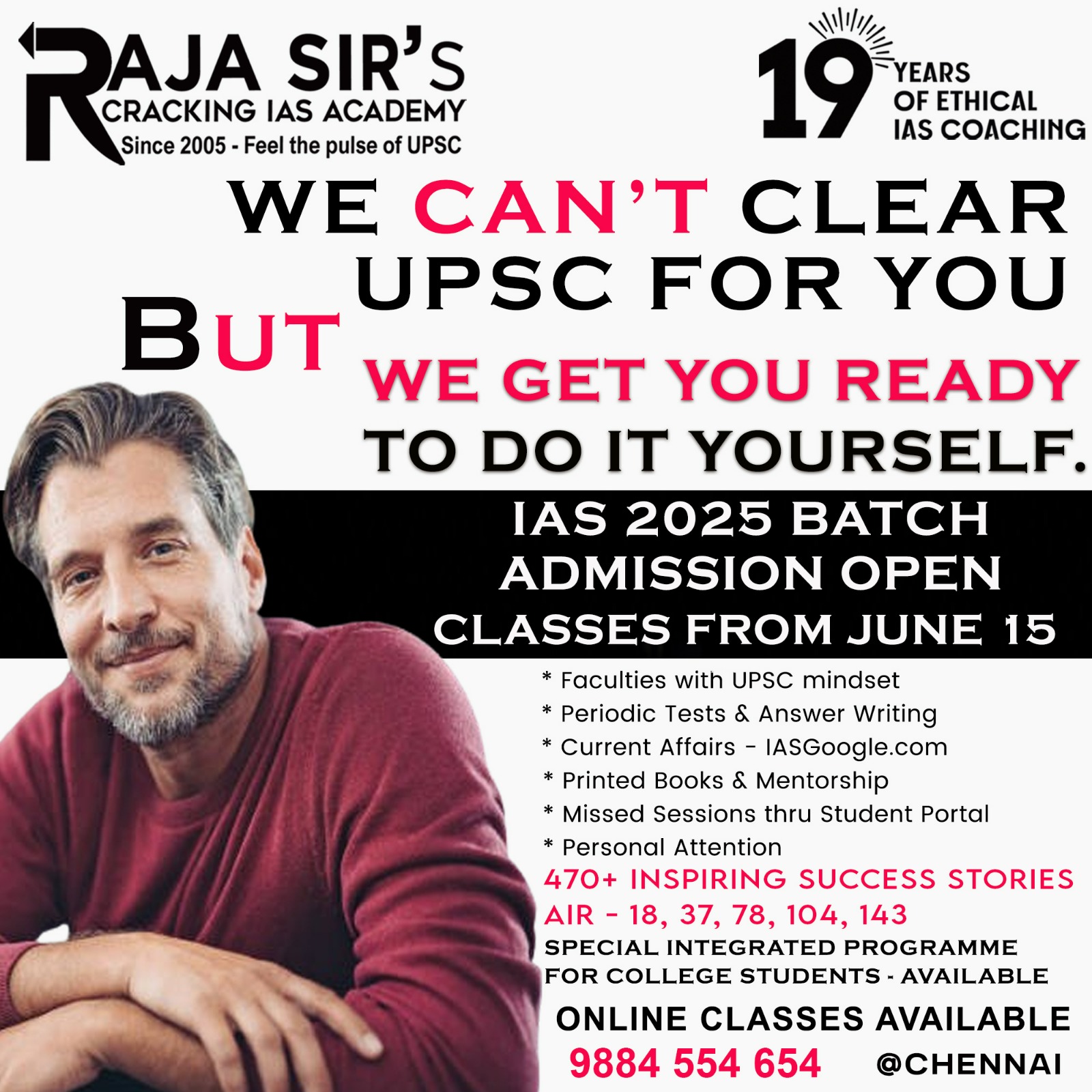
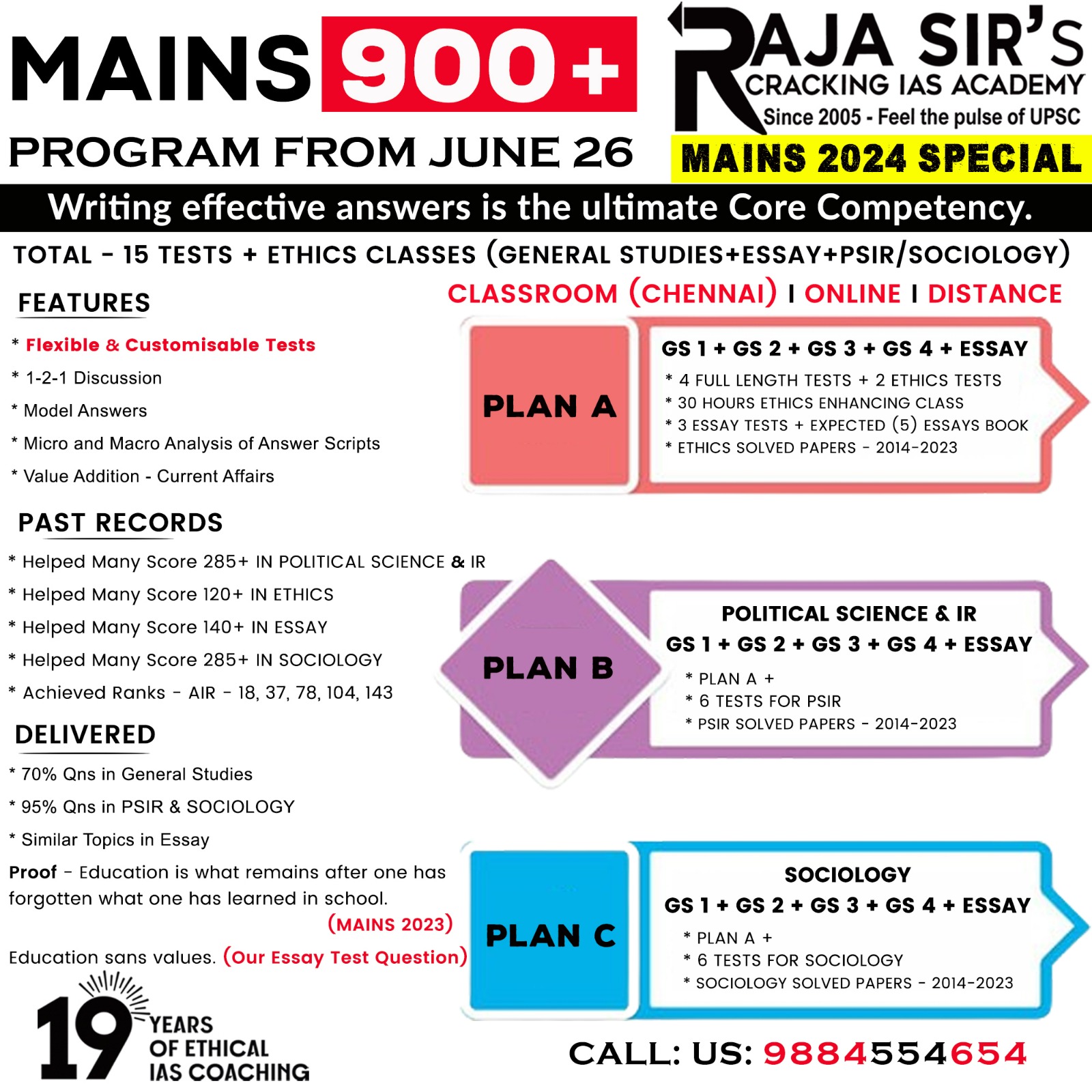
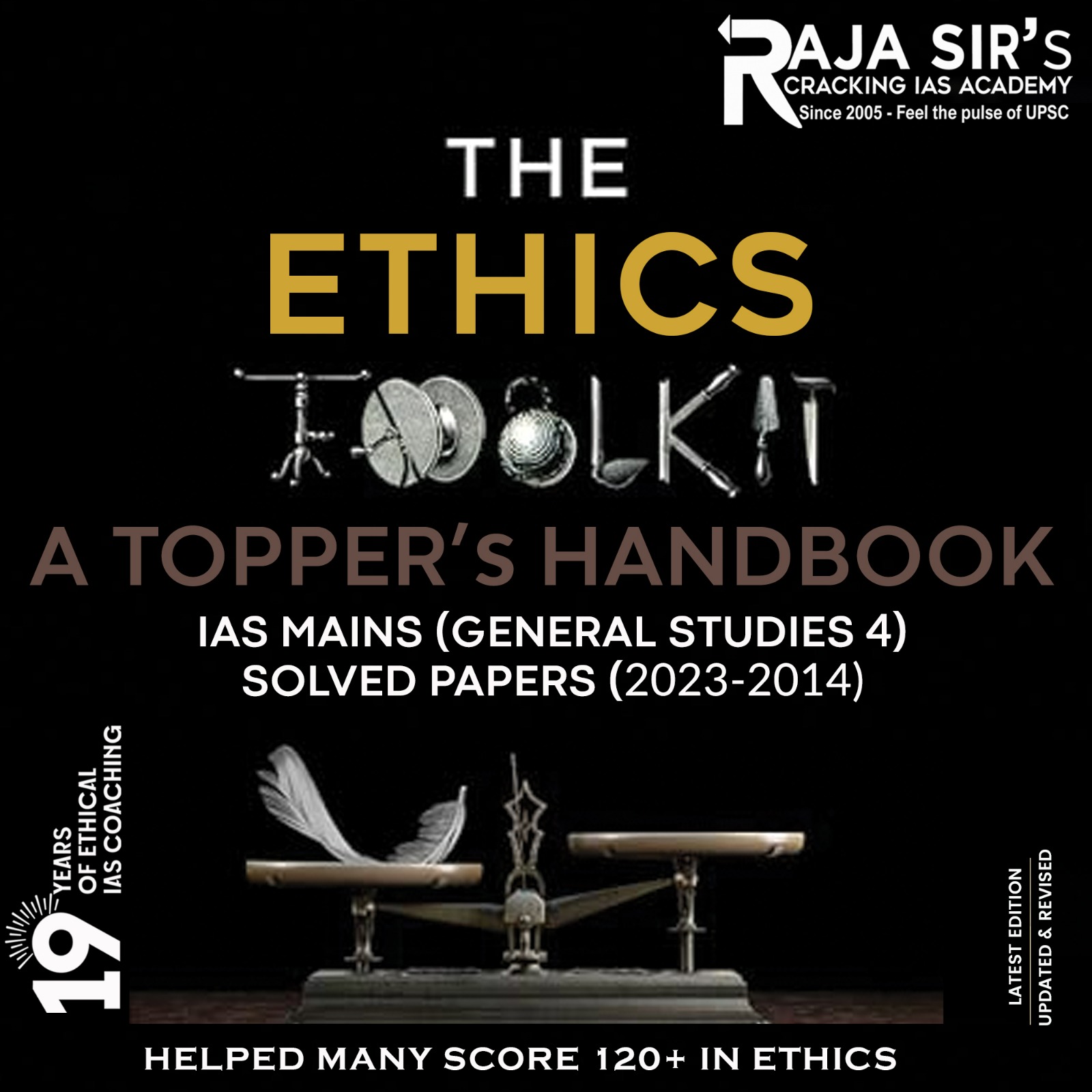
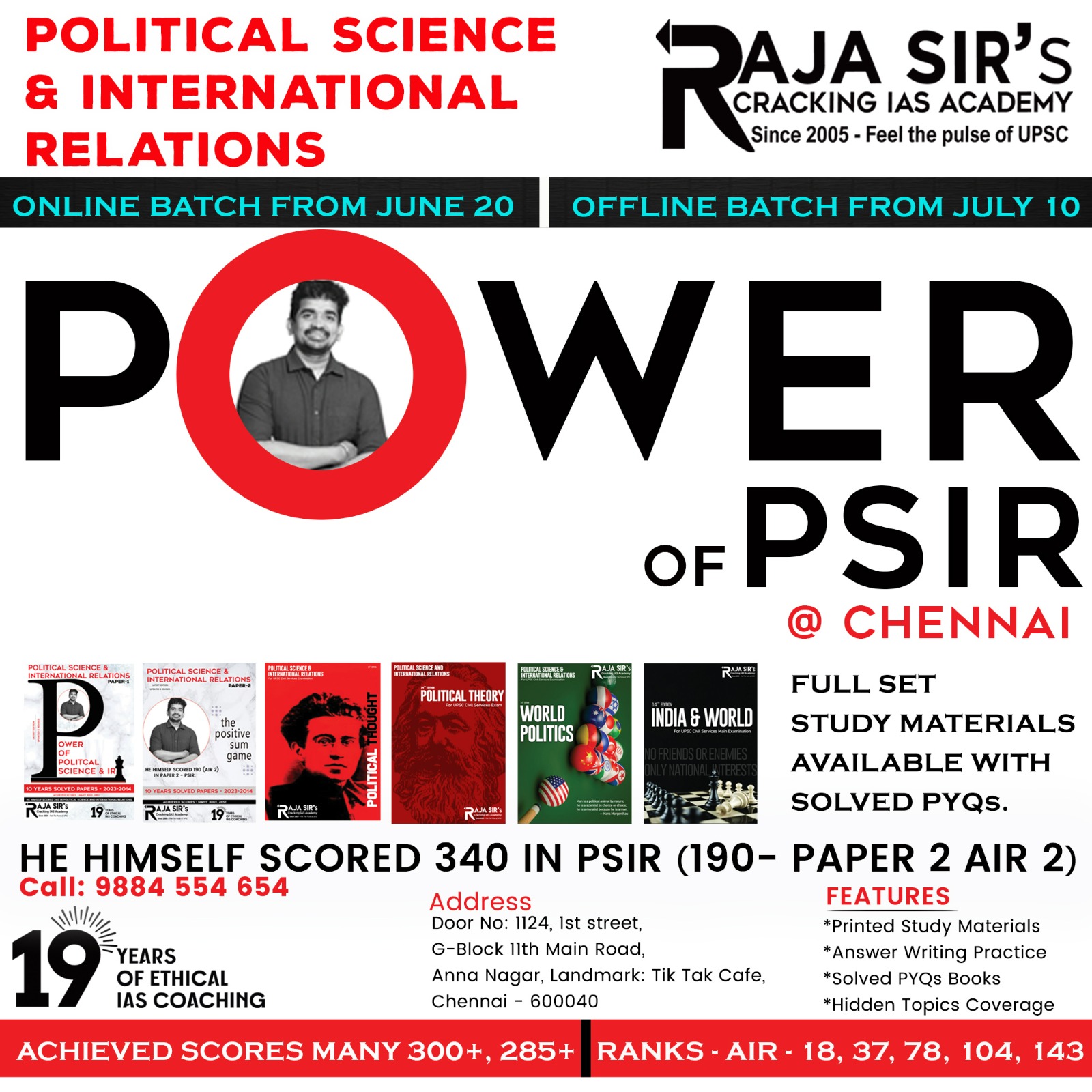
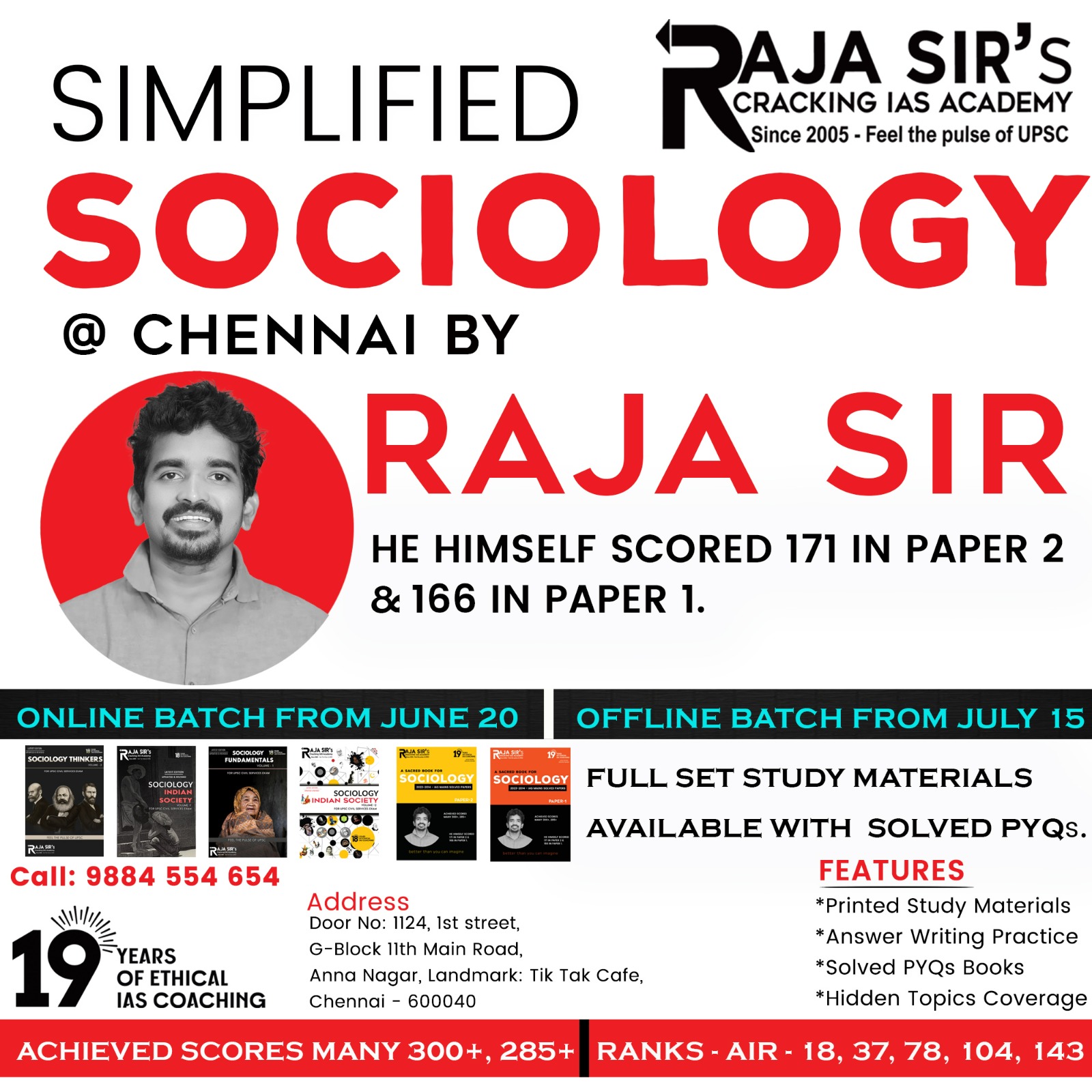
 General Studies
General Studies